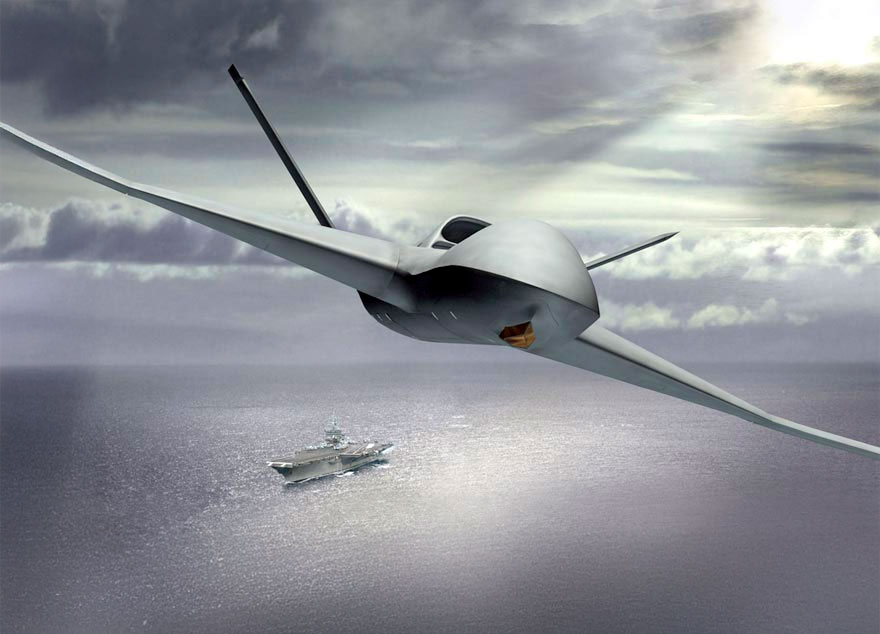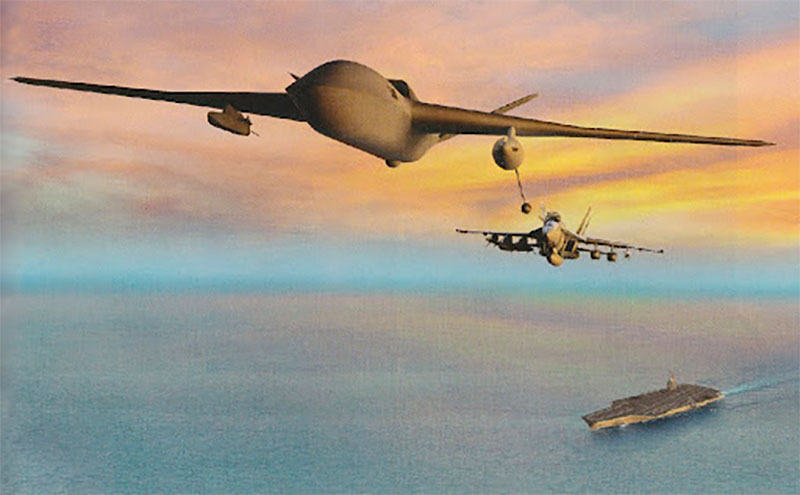The General Atomics Sea Avenger UCLASS is a carrier-capable unmanned drone designed for surveillance, strike, and extended operational endurance.
The General Atomics Sea Avenger is an unmanned carrier-capable drone developed as part of the Unmanned Carrier-Launched Airborne Surveillance and Strike (UCLASS) program. Designed to operate from aircraft carriers, it integrates advanced stealth features and extended endurance capabilities. Powered by a turbofan engine, the Sea Avenger can achieve high subsonic speeds while carrying a versatile payload. With a wingspan of approximately 70 feet (21 meters) and a maximum takeoff weight of 14,000 pounds (6,350 kilograms), it can perform reconnaissance and precision strike missions. The aircraft includes features such as folding wings for carrier storage, a weapons bay for internal armament, and modular systems for adaptability. Its advanced avionics and reduced radar signature make it a critical platform for modern naval operations. Although its operational status remains tied to evolving UCLASS requirements, it represents a leap in unmanned carrier-based aviation.
History of the development of the General Atomics Sea Avenger
The development of the General Atomics Sea Avenger emerged from the evolving demands of the U.S. Navy in the early 2000s. During this period, naval operations were increasingly shaped by the need for persistent surveillance, strike capability, and operational endurance. Traditional carrier-based aircraft, while effective, faced limitations in endurance and risk in contested environments. The Navy’s UCLASS program was initiated to address these gaps, aiming to develop an unmanned platform capable of conducting ISR (intelligence, surveillance, reconnaissance) and strike missions from aircraft carriers.
General Atomics’ entry into the UCLASS competition was rooted in its expertise with the Predator and Reaper drones, which had demonstrated their effectiveness in land-based operations. The Sea Avenger, unveiled in 2010, was designed as a carrier-capable derivative of the Avenger UAV. Its development was driven by the need for a platform that could integrate seamlessly into naval operations, featuring stealth, modular payloads, and long endurance.
The design incorporated advanced stealth features, folding wings for carrier storage, and a weapons bay for internal payload carriage. These elements aligned with the Navy’s goals of reducing the aircraft’s radar cross-section and increasing survivability in contested environments. Additionally, the Sea Avenger’s modular architecture allowed for the integration of various sensors, making it adaptable to diverse mission requirements.
The program’s timeline was influenced by shifting priorities within the Department of Defense. Initial requirements for UCLASS emphasized strike capabilities, but later iterations prioritized ISR roles, reflecting changing operational needs. Despite these shifts, General Atomics continued to refine the Sea Avenger’s design, emphasizing its versatility and alignment with carrier operations.
The Sea Avenger underwent significant testing phases, but its future became uncertain as the Navy’s focus shifted toward the MQ-25 Stingray program, which emphasized aerial refueling over strike capabilities. While the Sea Avenger’s development highlighted its potential, its operational deployment remains contingent on evolving military requirements. Nevertheless, the project underscored the growing importance of unmanned systems in modern naval warfare.

Design of the General Atomics Sea Avenger
The design of the Sea Avenger integrates advanced aerodynamics and stealth features to enhance its operational effectiveness. Its airframe is based on the Avenger UAV, with modifications tailored for carrier-based operations. The aircraft features a low-observable fuselage with smooth contours and minimal external protrusions to reduce its radar cross-section.
A key feature of the Sea Avenger is its folding wings, which allow it to fit within the limited storage spaces on aircraft carriers. The wingspan extends to approximately 70 feet (21 meters) during flight but folds compactly for storage. This capability ensures compatibility with existing carrier infrastructure.
The Sea Avenger is powered by a Pratt & Whitney PW545B turbofan engine, capable of producing 4,800 pounds (21.35 kN) of thrust. This engine provides the UAV with a high subsonic cruise speed and extended endurance, enabling it to cover long distances during missions. The aircraft’s fuel-efficient design and internal fuel tanks support extended operational ranges.
Its payload capacity exceeds 3,500 pounds (1,590 kilograms), distributed between an internal weapons bay and external hardpoints. The internal bay enhances stealth by reducing external drag and visibility. The UAV can carry precision-guided munitions, such as GBU-12 Paveway II bombs and AGM-114 Hellfire missiles, making it capable of precision strikes in addition to surveillance.
The Sea Avenger’s avionics suite includes advanced sensors and communication systems. It is equipped with an Electro-Optical/Infrared (EO/IR) sensor turret, synthetic aperture radar (SAR), and electronic intelligence (ELINT) systems. These components provide real-time data and imagery, critical for ISR missions.
Despite its strengths, the Sea Avenger faces challenges in stealth compared to platforms like the Northrop Grumman X-47B. However, its modular design and cost-effectiveness make it a versatile option for carrier-based operations. The UAV’s ability to integrate with existing naval systems ensures its relevance in multi-domain warfare.
Performance of the General Atomics Sea Avenger
The Sea Avenger’s performance is defined by its balance of endurance, speed, and payload capabilities. With a maximum takeoff weight of 14,000 pounds (6,350 kilograms), it can sustain long-duration missions critical for naval operations. Its Pratt & Whitney PW545B turbofan engine delivers thrust sufficient for high subsonic speeds, with a maximum cruise speed of approximately 400 knots (741 km/h).
The UAV operates effectively at altitudes of up to 50,000 feet (15,240 meters), providing a broad field of view for ISR missions. Its range exceeds 1,800 nautical miles (3,333 kilometers), making it suitable for extended operations in contested regions. The Sea Avenger’s fuel-efficient design ensures optimal performance during long-endurance flights.
Its payload capacity of 3,500 pounds (1,590 kilograms) accommodates a mix of sensors and munitions. The internal weapons bay supports stealth operations by reducing radar signature, while external hardpoints allow for additional armament when stealth is not a priority. The UAV’s weapons include precision-guided munitions such as GBU-38 JDAMs and AGM-114 Hellfire missiles, enabling it to perform both ISR and strike missions.
Compared to its competitors, such as the Northrop Grumman MQ-25 Stingray, the Sea Avenger excels in strike capabilities but lacks the dedicated aerial refueling focus of the MQ-25. Similarly, it offers greater endurance and operational flexibility than earlier UAVs like the Boeing ScanEagle. Its combination of speed, range, and payload capacity positions it as a versatile asset in modern naval warfare.
Variants of the General Atomics Sea Avenger
The Sea Avenger has primarily been developed as a single variant tailored for the UCLASS program. However, potential upgrades and modifications have been proposed to enhance its versatility and mission capabilities. These include:
- ISR-Optimized Variant: This version prioritizes advanced sensor integration, such as enhanced SAR and ELINT systems, to improve reconnaissance capabilities.
- Strike-Enhanced Variant: Equipped with additional hardpoints and upgraded weapon systems, this variant focuses on precision strike missions in contested environments.
Both variants share the core design features of the Sea Avenger, including stealth elements, folding wings, and modular architecture. Future developments could include the integration of more advanced propulsion systems or autonomous operation capabilities, further enhancing the UAV’s adaptability to evolving mission requirements.

Military use and combat of the General Atomics Sea Avenger
The Sea Avenger was developed to fulfill the U.S. Navy’s requirements for an unmanned platform capable of ISR and strike missions from aircraft carriers. Its advanced sensors and stealth features make it an ideal candidate for reconnaissance in contested environments. Although not yet deployed in active combat, the UAV’s design and capabilities indicate its potential effectiveness in modern warfare.
The Sea Avenger’s primary armament includes precision-guided munitions such as GBU-12 Paveway II bombs and AGM-114 Hellfire missiles, providing it with robust strike capabilities. These weapons enable it to engage ground targets with high accuracy, minimizing collateral damage. Additionally, its integration with advanced ISR systems ensures real-time data sharing with naval command centers, enhancing situational awareness and decision-making.
While the Sea Avenger has not yet participated in conflicts, it has been evaluated in simulated carrier operations to test its compatibility with naval environments. Competing platforms, such as the Northrop Grumman X-47B, offer fully autonomous capabilities, but the Sea Avenger’s modular design provides greater flexibility for adapting to diverse mission requirements.
The UAV has not been exported to other countries, reflecting its focus on U.S. Navy requirements. However, potential future sales could target allied nations seeking advanced carrier-capable UAVs. Its operational future remains tied to the evolution of naval UAV programs, including the shift toward the MQ-25 Stingray, which prioritizes aerial refueling capabilities.
The General Atomics Sea Avenger UCLASS drone combines advanced stealth, endurance, and payload capabilities, making it a versatile platform for ISR and strike missions. While its operational future is uncertain due to shifting program priorities, its design and performance highlight its potential as a carrier-capable unmanned asset.
Back to the Drones, UAVs, UCAVs page